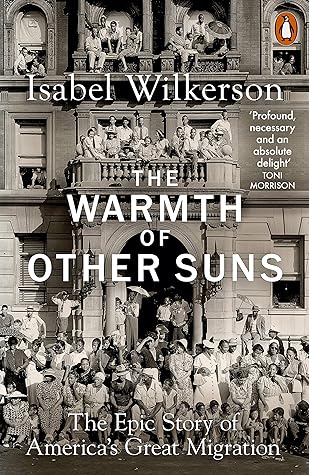More on this book
Community
Kindle Notes & Highlights
Read between
July 16 - September 3, 2024
The Great Migration would become a turning point in history. It would transform urban America and recast the social and political order of every city it touched. It would force the South to search its soul and finally to lay aside a feudal caste system.
In Chicago alone,10 the black population rocketed from 44,103 (just under three percent of the population) at the start of the Migration to more than one million at the end of it. By the turn of the twenty-first century, blacks made up a third of the city’s residents, with more blacks living in Chicago than in the entire state of Mississippi.
The layers of accumulated assets built up by the better-paid dominant caste, generation after generation, would factor into a wealth disparity of white Americans having an average net worth ten times that of black Americans by the turn of the twenty-first century, dampening the economic prospects of the children and grandchildren of both Jim Crow and the Great Migration before they were even born.
Southern states made no pretense as to the lopsided division of resources to white and colored schools,7 devoting as much as ten dollars per white student for every dollar spent on a colored student and showing little interest beyond that meager investment.
The war had cut the supply of European workers the North had relied on to kill its hogs and stoke its foundries. Immigration plunged by more than ninety percent,22 from 1,218,480 in 1914 to 110,618 in 1918, when the country needed all the labor it could get for war production. So the North turned its gaze to the poorest-paid labor in the emerging market of the American South.23 Steel mills, railroads, and packinghouses sent labor scouts disguised as insurance men and salesmen to recruit blacks north, if only temporarily.
“As the North grows blacker,25 the South grows whiter,” the New Orleans Times-Picayune happily noted.
“Every Negro that makes good in the North and writes back to his friends,35 starts off a new group,” a Labor Department study observed. So the South tried to choke off the flow of information about the North. The chief of police in Meridian,36 Mississippi, ordered copies of the Chicago Defender confiscated before they could be sold, fearing it was putting ideas into colored people’s heads.
There were two blacks among the forty-four settlers who founded Los Angeles on September 4, 1781.
By 1900,5 there were only 2,131 black people in the city of Los Angeles out of a total population of 102,479, and only 11,045 in the entire state of California. The numbers rose slowly but steadily over the years but did not take off during the labor shortage of World War I as in the North.
colored migrants to California faced stiff competition from the many immigrants already there, the Mexicans and Filipinos working the loading docks, the Europeans in personal service to the glamorous and the wealthy. “Even the seeming inapproachable shoe-shining field was competed for by the Greeks,”
The percentage of postwar black migrants who had graduated from high school was as high as or higher than that of native whites in New York, Cleveland, Philadelphia, and St. Louis and close to the percentage of whites in Chicago.
“Black men who have been out of the South for five years or more are,17 in every instance, more likely to be in the labor force than other black men in the North,”
Dwellings that went for eight to twenty dollars a month to white families were bringing twelve to forty-five dollars a month from black families,40 those earning the least income and thus least able to afford a flat at any rent, in the early stages of the Migration. Thus began a pattern of overcharging and underinvestment in black neighborhoods that would lay the foundation for decades of economic disparities in the urban North.
Compared to the northern blacks already there, the migrants were more likely to be married and remain married, more likely to raise their children in two-parent households, and more likely to be employed. The migrants, as a group, managed to earn higher incomes than northern-born blacks even though they were relegated to the lowest-paying positions. They were less likely to be on welfare than the blacks they encountered in the North, partly because they had come so far, had experienced such hard times, and were willing to work longer hours or second jobs in positions that few northern blacks,
If anything, the scholars found, the migrants who stumbled were brought down by the conditions of the northern cities, not the other way around. “Instead of thinking of southern migrants as the ‘culprits’10 in changes that have occurred in the urban black family during this century,” Tolnay and Crowder wrote, “it may be more accurate to think of them as the ‘victims’ of their new residential milieu.”


